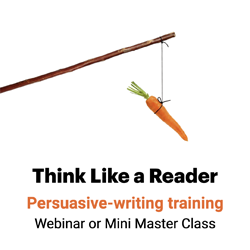Take a tip from the author of How to Win Friends and Influence People
I was coaching a communicator for a California health insurance plan the other day. The headline for her news story:

Provide Care to XYZ HMO Members
Oy! If only “Do it ’cause I said so” messages actually worked. That would make my life a lot easier! But nobody’s swayed by a scream. So I reminded my client of Dale Carnegie. In 1936, the author of How to Win Friends and Influence People wrote:
“There is only one way under high heaven to get anybody to do anything. By making the other person want to do it.”
So, Carnegie wrote:
“Before you [communicate], pause and ask yourself: ‘How can I make this person want to do it?’”
How can you make your readers want to do what you want them to do? That’s your headline.
Dale Carnegie’s persuasive techniques
Here’s what I learned from Dale Carnegie’s classic techniques in the art of persuasion:
It’s all about the other person.
That’s it. That’s how you win friends. That’s how you influence people.
Forget logical arguments. Forget mirroring your clients’ body language. Just take the other person’s point of view.
People aren’t interested in us and our stuff. They’re interested in themselves and their needs. If you would persuade people, Carnegie writes:
“Remember that the people you are talking to are a hundred times more interested in themselves and their wants and problems than they are in you and your problems. A person’s toothache means more to that person than a famine in China which kills a million people. A boil on one’s neck interests one more than forty earthquakes in Africa.”
So what are your writing about? Your neck-boil remedy? Or the reader’s aching neck?
“If salespeople can show us how their services or merchandise will help us solve our problems, they won’t need to sell us. We’ll buy. And customers like to feel that they are buying — not being sold.”
It seems so obvious that the topic is the topic. But if you want to change minds and behavior, you need to make the reader the topic.
“People are not interested in you. They are not interested in me. They are interested in themselves — morning, noon and after dinner.”
And on the phone. Definitely on the phone.
“The New York Telephone Company made a detailed study of telephone conversations to find out which word is the most frequently used. You have guessed it: it is the personal pronoun ‘I.’ ‘I.’ ‘I.’ It was used 3,900 times in 500 telephone conversations. ‘I.’ ‘I.’ ‘I.’ ‘I.’”
Any questions?
“When you see a group photograph that you are in, whose picture do you look for first?”
Me too. I’m my own favorite subject.
“‘Talk to people about themselves,’ said Disraeli, one of the shrewdest men who ever ruled the British Empire, ‘and they will listen for hours.’”
Are you talking about the reader?
Highlight the subjects of each of your sentences. How many of them refer to the reader? How many refer to your organization or your products, services, programs and ideas? Write more of the former and less of the latter.
That’s how you Win Friends and Influence People. Make it about them.

Leave a Reply